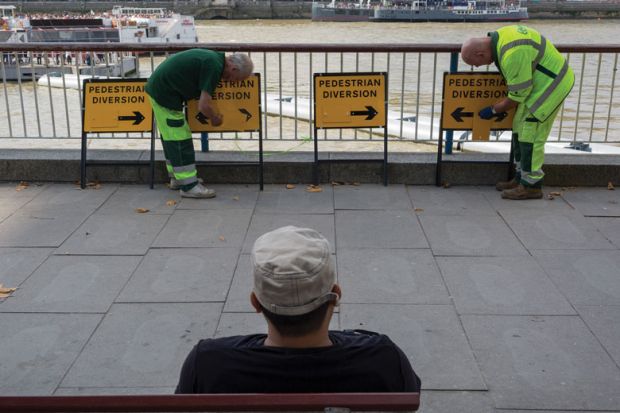The wide variation in policies on wearing face coverings across UK universities sends “mixed messages” to students and risks harming compliance, an academic has warned.
A spreadsheet compiled by academics across the country reveals that only 20 out of the 91 institutions listed will require the wearing of masks in all teaching spaces, with a further 19 stating that it is “expected”.
Twelve of the institutions mandating masks are in Scotland, where the Holyrood government has made their use on campus a legal requirement.
Among institutions not mandating masks, some say that their use is “encouraged”, while others say it is a matter of “personal” choice. There is also significant variation in whether universities ask students to wear masks when moving around campus buildings.
The spreadsheet was created by Andrew Chitty, until recently a senior lecturer in philosophy at the University of Sussex, who highlighted that there were a number of cases in which universities gave different guidance on different pages of their websites.
“Overall, there is absolutely no consistency across the sector in the UK,” Dr Chitty said.
Simon Williams, senior lecturer in people and organisation at Swansea University, said, “when you have such mixed messages, it harms buy-in”.
“When there are such different approaches and policies across institutions, it just gets confusing for people. If a student in one university realises their friends in another don’t have to wear masks, it makes them question the need,” he said.
Since Times Higher Education conducted its own survey of 65 universities this summer, some appeared to have relaxed their rules. The University of Bolton had stated that masks were mandatory on campus, but it now says “social distancing and face coverings now [are] NOT mandatory, but we hope you will choose to wear them”.
The University of East Anglia has toned down its policy’s language, from “required” to “strongly encouraged”.
The Independent Sage group of scientists has urged “universities to go beyond current government recommendations” and make the use of face coverings in communal study and workspaces a requirement, in a bid to stop the spread of coronavirus.
“No one particularly likes wearing masks, but it is less of a sacrifice than other preventive measures, such as lockdowns,” Dr Williams said. “It’s also important to put it into a global perspective; in the US, for example, many institutions have vaccine mandates.”
Dr Chitty created a similar document that found that only 18 universities so far have said that they are using carbon dioxide monitors to check on the adequacy of their buildings’ ventilation, and just five have publicly adopted benchmark carbon dioxide levels.
The data emerge amid continuing concern that the return to face-to-face teaching will drive a spike in Covid-19 cases in university communities.
“Some universities are sending a strong and consistent message on wearing face coverings and are implementing a systematic and transparent programme of ventilation checking,” Dr Chitty said.
“But many others are doing neither, to the point where it is hard to see that they are fulfilling their legal duty under the Health and Safety Act 1974 to ensure as far as is ‘reasonably practicable’ the health, safety and welfare of their staff and students.”





